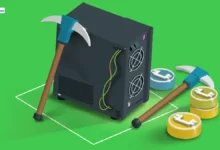Kadena (KDA) Things You Need To Know Before Investing

Table of Contents
What Is Kadena (KDA)?
Kadena (KDA) is a proof-of-work blockchain that combines the PoW consensus mechanism from Bitcoin with directed acyclic graph (DAG) principles to offer a scalable version of Bitcoin. KDA claims it can provide the security of Bitcoin while being able to offer unparalleled throughput that makes the blockchain usable to enterprises and entrepreneurs alike. KDA’s unique infrastructure is decentralized and built for mass adoption because of its multi-chain approach.
KDA promises industrial scalability that can support global financial systems and be scaled as necessary. It also vows to remain energy-efficient at scale and deliver more transactions with the same energy input, another difference from Bitcoin. Moreover, KDA offers crypto gas stations, which allow businesses to pay for their customers’ gas fees and remove a huge pain point in adopting blockchains for business.
Kadena has already scaled its network from 10 to 20 blockchains and can do so again in the future, if necessary. This final addition to KDA was its private Kuro layer-two blockchain, which supports up to 8,000 transactions per second across 500 nodes.
Who Are the Founders of Kadena?
Kadena was founded in 2016 by Stuart Popejoy and Will Martino. Before founding KDA, Stuart Popejoy led JPMorgan’s Emerging Blockchain group and has 15 years of experience building trading systems and infrastructure in finance. Will Martino was the Lead Engineer for JPMorgan’s blockchain prototype Juno and led the Securities and Exchange Committee’s Cryptocurrency Steering Committee and Qualitative Analytics Unit. Another key persona in founding KDA was Dr. Stuart Haber, the co-inventor of blockchain technology and the most cited author in the Bitcoin whitepaper.
Furthermore, Kadena raised capital from many crypto venture capitalists like Multicoin Capital, CoinFund, Amino Capital, and others.
What Makes Kadena Unique?
Kadena offers a public proof-of-work blockchain with unparalleled throughput by combining two separate consensus mechanisms: DAG and proof-of-work.
In simple terms, KDA achieves this by braiding chains together, meaning it offers not one but several (20) separate blockchains that all work simultaneously and asynchronously to validate transactions. This allows KDA to mint multiple blocks simultaneously, thus increasing its throughput. This also increases security by reducing an attacker’s time between block confirmations.
KDA uses a directed acyclic graph structure to scale from one proof-of-work blockchain to theoretically an unlimited amount. However, its DAG structure is fixed and multi-channel, meaning Kadena’s blockchains only communicate with three peer chains instead of randomly confirming transactions. This improves real-world performance and scalability.
KDA can scale as required by the needs of its users. However, the main limitation is adoption, as scaling and adding additional blockchains require the network to undergo a hard fork. In theory, KDA can scale to 50 or 100 blockchains or even more if it demonstrates continued adoption. The process is not automatic: once the network becomes congested, fees rise and miners forming a DAO are incentivized to cooperate in reconfiguring the network to a larger size.
How Many Kadena (KDA) Coins Are There in Circulation?
KDA is the blockchain’s native token with a total supply of 1 billion KDA. It is used to pay for gas and a miner reward for producing new blocks. Kadena pre-mined several rounds of KDA. The first private token sale was in 2018 and raised $2.25 million for 4.5 million KDA. The second round raised $12.9 million for 17.2 million KDA. The distribution of KDA looks as follows:
- Mining: 700 million to be emitted over 100+ years
- Platform share: 200 million to be emitted over nine years
- Investors, strategic reserve, and contributors: 90 million
- Burned at launch: 10 million
Currently, 171 million KDAs are circulating. The token emissions schedule will decrease gradually over time, and the entire Kadena tokenomics model can be found here.
How Is the Kadena Network Secured?
Kadena uses a chain architecture called Chainweb to combine its several proof-of-work blockchains. Each chain confirms its three peer chains’ blocks, thereby increasing throughput linearly with the addition of new chains. This also increases security as Kadena chains achieve a single view of transaction history across chains. An attacker would have to fork not one chain but all the running chains to attack just one.
Kadena’s innovative contract language is called Pact and is human-readable, and Turing-incomplete language is built explicitly for blockchains with robust security features.
Where Can You Buy Kadena (KDA)?
KDA is available on Binance, OKX, Mandala Exchange, KuCoin, and Gate.io.
Also Read: Livepeer (LPT) Things You Need To Know Before Investing








